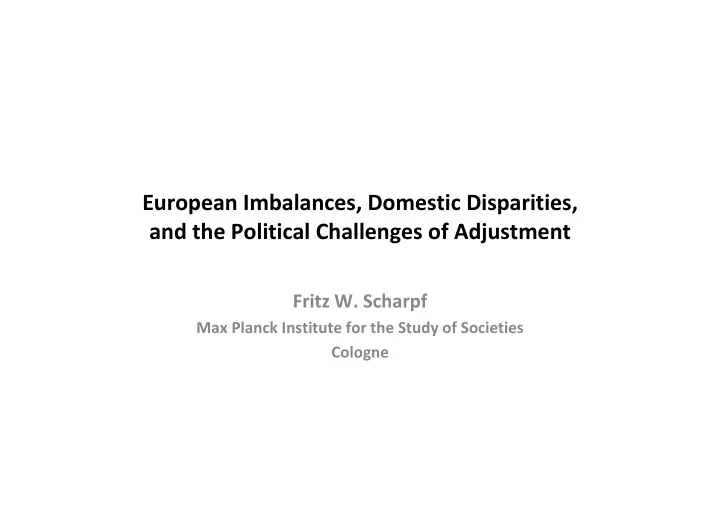

European Imbalances, Domestic Disparities, and the Political Challenges of Adjustment Fritz W. Scharpf Max Planck Institute for the Study of Societies Cologne
The Monetary Union as an Imbalance ‐ Producing Institution � Monetary Union 1999: Shaped after Bundesbank Model � BUT: BB policy was precisely targeted to German conditions � EMU with 11 (now 17) heterogeneous members � Economic structures (agriculture, industry, services) � Industrial relations (concentrated/fragmented; cooperative/antagonistic) � Political (centralized/decentralized; consensual/competitive
The Monetary Union as an Imbalance ‐ Producing System � Unitary monetary policy for divergent economies oriented to Eurozone averages � Too loose for hi ‐ growth/hi ‐ inflation GIPS economies � Too restrictive for low ‐ growth/low inflation Germany � 2000 ‐ 2005: Germany, the „sick man of Europe“ � Highest real interest rates, lowest growth, rising unemployment, falling real wages
The Monetary Union as an Imbalance ‐ Producing System 2000 ‐ 2007: GIPS economies: Credit ‐ financed boom � Low or negative real interest rates � Economic growth � Low or falling unemployment � Rising real wages � BUT: Growing macroeconomic imbalances � Diverging unit labor costs � Diverging current accounts � Diverging capital accounts
Before 2008: • Fiscal policy was not the problem (certainly not in Ireland and Spain) • Macroeconomic imbalances caused by uniform monetary policy in economicallly non ‐ uniform Eurozone economies
After 2008: Macroeconomic Imbalances + Financial Crisis � Sovereign Debt Crisis • 2007/08: International financial (Lehman) crisis � Banks rescued by states (but not in Spain) � Credit squeeze hits real economies � Credit ‐ dependent GIPS economies hit hardest � Real ‐ estate bubbles bursting in Ireland and Spain � � Steeply rising state debt � � Steeply rising risk premia on state bonds � � Threat of sovereign insolvency
Adjustment: Two Conflicting Requirements • Servicing accumulated debt to prevent insolvency � Rescue loans and guarantees by EU and IMF � Fiscal retrenchment enforced through conditionalities � Restoring economic growth and employment � Stabilizing domestic demand � Restoring international viability � Challenge: Diverging real effective exhange rates BIGGS overvalued, Germany undervalued
Problems of Present Adjustment Strategies I (domestic recovery) � Domestic demand reduced by fiscal retrenchment � Domestic demand depressed by ECB interest rates � Nominal rates too high for GIPS, too low for Germany � ECB likely to raise interest rates � Real interest rates extremely high in GIPS � Domestic recovery prevented by present strategy
Problems of Present Adjustment Strategies II (external competitiveness) � Competitiveness achieved through real devaluation? � Model: Germany 2001 ‐ 2006: union wage restraint ?? BUT: Divergence is so much greater. Export industries?? � Requires: Drastic (nominal) wage cuts in export sector Political feasibility? Effectiveness? (UK experience in the 1970s) � Requires: Significant increases in post ‐ tax profits Political feasibility?
Problems of Present Adjustment Strategies III (legitimacy) � Democratic self ‐ determination in GIPS polities? � Legitimacy of supranational (Troika) dictates? � Effect of inter ‐ national confrontation on EU?
In Short • Present Adjustment Strategy – Economically unpromising – Politically dangerous at domestic level – Politically dangerous at European level • � Need to explore policy alternatives
Policy Options Not Considered (that might help GIPS recovery) � ECB allowing higher average rate of inflation ? � Real interest rates lower for GIPS, higher for Germany � ECB attempting differentiated monetary policy ? � Nominal interest rates lower for GIPS, higher for Germany � Debt restructuring + transfers (instead of credits) ? � GIPS countries leaving Monetary Union ? � Germany leaving Monetary Union ?
Recommend
More recommend